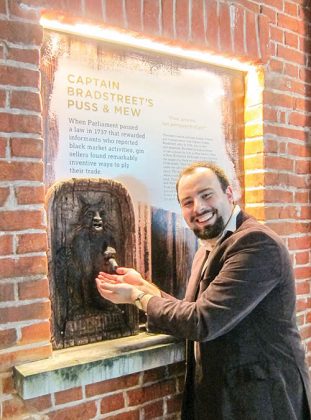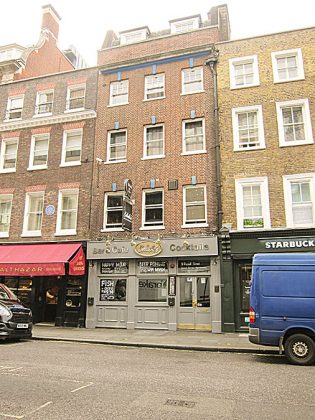Spirit and cocktail history is a strange thing; it is rare that the definitive truth will ever be discovered, and the history at any one time just gives a snapshot of our understanding. Ask any drinks historian worth their salt and you are bound to hear an anecdote of how the history of a particular drink was turned on its head when a scrap of paper, obscure reference or old advertisement was found.
In addition, there are a whole myriad of myths and legends that spring up around drinks history that writers have to pick their way through. After all, imbibing alcohol is fuel to the long-tale teller.
Since the publication of my book, Forgotten Spirits & Long Lost Liqueurs, additional information has been uncovered about one of gin’s biggest mysteries: the origin of Old Tom. This refers to where the name itself comes from, rather than why the style exists or what it originally tasted like.
The style existed to cover up impurities in the base spirit—it was created before the invention of continuous distillation—so discussion of a truly authentic 21st-century version is mute, unless a distiller wanted to admit to using inferior spirit.
One of the earliest, often-quoted references to Old Tom Gin is in Dudley Bradstreet’s The Life and Unusual Adventures of Captain Dudley Bradstreet, published in 1755. In this book, the author describes a caper where he got around licensing restrictions by creating a sort of gin vending machine, where a customer would deposit a coin in the mouth of a cat-shaped sign and be provided with a measure of gin via a pipe under the cat’s paw.
This is a great story and certainly one that has helped to maintain the connection between cats and Old Tom; however, a closer inspection of the text reveals that at no time does Bradstreet refer to “Old Tom” or “Tom Gin,” so it is difficult to see how this can be the earliest reference to Old Tom Gin if the term is not even mentioned.
The earliest reference I have found to Old Tom is in an 1812 edition of the Northampton Mercury.
A newer origin story comes from Slang: A Dictionary of the Turf (1823), a guide to the colloquial language of the racecourse, which is (to say the least) a rather difficult read.
Old Tom—he is of the feminine gender in most other nations than this: ‘tis a cask or barrel, containing strong gin, and thence by a natural transition from the thing containing to that contained—the liquor itself.”
To interpret, the suggestion is that Old Tom is named after an alternative name for barrels (i.e., “tuns”). Today, a “tun” is usually thought to be 252 US gallons (953.92 liters), although in the 19th century the term was used more loosely. For example, the Heidelburg Tun, in Germany, is more than 200 times larger at 58,574 US gallons (221,726 liters).
Even though this is the earliest recorded reference, it does not mean it is necessarily the right one. The evolution from “tun” to “ton” to “Tom” may make sense, but the “old” doesn’t. All spirits at the time were sold in barrels, so why weren’t other spirits known as Old Tom? However, it is a nice historical nod for those Old Toms that are rested in casks, such as Ransom, Downslope, and Barr Hill Tom Cat.
Another story comes from Brewer’s Dictionary of Phrase and Fable (1870), which describes events from earlier in the century.
Old Tom. Cordial gin. Thomas Norris, one of the men employed in Messrs. Hodges’ distillery opened a gin palace in Great Russell Street, Covent Garden, and called the gin concocted by Thomas Chamberlain, one of the firm of Hodges, “Old Tom” in compliment to his former master.
In order for this story to make sense, both Thomas’ would need to be adults before 1812 and be working in their suggested professions.
• Benjamin George Hodges (1779–1843)
The Hodges Distillery did, indeed, exist: The 1794 Directory of “London Westminster & the Borough of Southwark” records Hodges being a distiller in Millbank. By 1827, the distillery had moved from Millbank to Church St. (now Lambeth Road) in Lambeth.
• Thomas Chamberlain (1756–1816)
Birth and death records are available for Thomas Chamberlain and his will states his occupation as “Distiller, Millbank.”
• Thomas Norris
Norris is the greatest mystery in the story, largely because of a couple of errors by Brewer’s. Firstly, Norris ran a pub, not a gin palace (gin palaces did not really appear in London until the late 1820s, with the wide adoption of the gas lamp), and the establishment that he ran was not in Great Russell Street (home of the British Museum), but in Russell Street (directly adjacent to Covent Garden piazza).
So far, this story checks out, although there is no evidence that Norris worked with Chamberlain. Even just having the addition of Norris’s birthdate would help establish his age and determine whether he was young enough to have been apprenticed under Chamberlain.
However, it would seem quite an elaborate hoax to make up this story for publication over half a century after the event, and particularly devious, too, as it would seem that the hucksters didn’t even trouble themselves to get the details right. However, this reasoning still does not amount to proof.
A final story regarding the origins of Old Tom tells of a cat falling into a vat of gin. This story actually relates to the origin of the logo of one particular gin company, Boord’s. Recalled in Boord and Son v. Huddart in 1903, the plaintiffs recount their inspiration for their logo, which they started using in 1849. They even refer to having been mocked at the time for using a cat and barrel on their logo.
In Conclusion
As previously mentioned, our current view of history is just a snapshot of our understanding at a certain time. Even by 1910, the origin story for Old Tom was thought to be “lost in obscurity.” Whilst truth and fact are essential in history, the legend has value, too: The cat and paw sign or the cat falling into a vat each capture the imagination and encourage people to seek out Old Tom.
No doubt more will be unveiled one day, but until then, fact and fiction sit together in a happy compromise.











